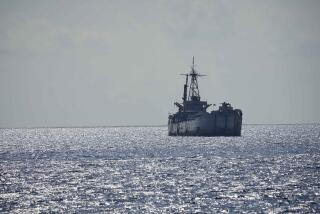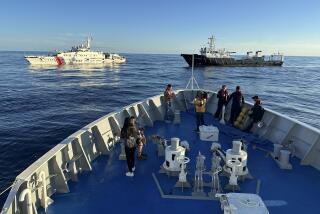U.S. Drills in Philippines May Be Model for Future
- Share via
ISABELA, Philippines — Two Marines stand guard for every Navy Seabee working to clear an old airstrip on the island home of Abu Sayyaf guerrillas.
The Americans and a handful of Filipinos work inside a ring of Philippine soldiers, where stray livestock can trigger trip wires that send up flares and set Marine snipers on alert. On the other side of Isabela, where the concrete of Basilan island’s only city ends abruptly and a dirt track hugs a palm-strewn shoreline, an American Green Beret captain supervises marksmanship training for Philippine army rangers, who two months earlier were firing on rebels a few miles away.
Four months into this U.S.-Philippine military operation, defense officials are struggling for terms to describe it. The Pentagon calls it an advisory mission. Col. Danilo Servando, a Philippine army spokesman, somewhat apologetically describes it as “a training exercise. That is the legal terminology that we are using.”
Yet the six-month regimen that began in January is unlike anything either military has experienced before. A training exercise usually means two to four weeks at an isolated site, carefully orchestrated to avoid contact with civilians. In decades of mutual military cooperation, neither country has trained on this scale on a battleground.
Islamic extremists of the Abu Sayyaf movement here in southern Mindanao province are believed to be holding two Americans and a local nurse hostage as they wage a guerrilla war against the Philippine government. The United States is offering a $5-million reward for the capture of the Abu Sayyaf leaders, the U.S. Embassy in Manila announced today.
This experimental military exercise could well be repeated in other trouble spots in the American-led war on terrorism, where support for a U.S. military presence is often ambiguous at best. Leaders in Malaysia and Indonesia are watching the venture for possible applications to their own struggles with terrorists, said U.S. Army Brig. Gen. Donald Wurster, the top commander of U.S. soldiers in the region.
It is an exercise in which protecting the troops consumes much of the mission and Green Berets stretch to devise creative military strategies--and vague language--to abide by the Philippine Constitution, which bans foreign troops from operating here except in certain military exercises.
Even if it is called an exercise, “in Basilan, you have a live, moving, running enemy, and you have a real mission: recovery of the Americans and the capture of Abu Sayyaf,” said Rudolfo Biazon, a Philippine opposition senator and a retired four-star general. “Basilan is a combat zone.”
A chart labeled “Combat Scorecard” on the wall of the Manila headquarters of the Philippine armed forces records the official tally of war dead: 41 government soldiers and 161 alleged Abu Sayyaf separatists in recent years. An additional 194 government fighters and 11 militants are listed as wounded in action. Dozens of Mindanao residents have been killed in terrorist bombings and slayings linked to the rebel effort to carve out a Muslim state.
Most of the casualties have occurred on Basilan, which is now the heart of the U.S.-Philippine exercise. Philippine commanders believe that in the dense central jungle of this tropical island the size of Oahu, near the southern tip of the Philippine archipelago, 80 to 100 rebels are holding American missionaries Martin and Gracia Burnham and Philippine nurse Deborah Yap.
On Basilan and at the regional military headquarters, located a ferry ride away in Zamboanga, the 660 U.S. troops are working to improve the Filipinos’ marksmanship, teamwork, map- and compass-reading skills, medical emergency response capability and nighttime operating abilities. The Green Berets, meanwhile, are picking up survival techniques and jungle warfare training unavailable anywhere in the United States, including how to catch and skin a lizard. Navy SEALs run Filipino SEALs through water drills.
The limits imposed on the Americans can be finessed.
Rules of engagement delicately negotiated by the two countries bar the Americans from direct combat and allow them to fire only in self-defense. That often leaves Col. David Fridovich, commander of the soldiers from the Army’s 1st Special Forces Group in the Philippines, asking, “How creative can I get?”
Green Berets have traveled to a command post deep in the jungle where the Abu Sayyaf is believed to be hiding with its hostages. Philippine army officials report that some Americans have participated in actions that fall just short of military patrols. If the Filipinos want advice on a problem, they can often get it.
“Am I going on operations? No,” Fridovich said in an interview. “But I’m certainly advising and assisting to a specific need.”
“It looks a lot like combat, but it’s counter-terrorism activity,” said Wurster, who declined to say in detail everything his men are doing, in order to preserve advantages against the rebels. “Just know that if you get near them, they’ll kill you.”
The American soldiers on the island say operating amid a live threat sharpens their attention.
Still, except for marksmanship training, “as far as I know, the Americans haven’t fired a single shot,” said Biazon. Nor have any been shot.
Fridovich calls the training “absolutely real.” In a sniper pit protecting airstrip construction workers, Marine Pfc. Anthony Forrester has to distinguish possible rebels from civilians who have long used the strip as a road.
The men don’t sleep well, and they’re not supposed to, said Wurster.
“I’ll undo the flap on this pistol when I go to bed tonight,” said Wurster, patting his M-9 sidearm.
One Philippine colonel said the Americans feel “cloistered.” But few American soldiers interviewed expressed impatience with the unusual mission.
“We’ve been waiting awhile,” Green Beret Capt. Douglas Kim said as he supervised a dozen Philippine rangers at a Basilan firing range last week. “We just do what we’re told. If they tell us to go out there, we’ll go do it.”
Abu Sayyaf once owned the night because the Philippine military had no night-flying capability. The Americans have helped equip and train them to operate around the clock. An army that used to practice marksmanship only during the day now conducts missions in darkness, although only one Philippine company has night-vision goggles, said Col. Paterno Renato Padua, commander of the Philippine army’s Scout Ranger Battalion.
Now, said a smiling Padua, “the night is our friend.”
American medical training has saved lives, Philippine commanders say. Seven Philippine soldiers were wounded in a March 21 firefight with Abu Sayyaf. The medics who gave them first aid were trained by the Americans, and U.S. Chinook helicopters pulled the casualties from Basilan.
Other Americans on Basilan are pursuing a kind of construction-for-peace plan. Seabees are refurbishing the 1946 airstrip for the Philippine military to use. There are Navy and Marine teams building wells, piers and bridges on 11 projects that have the added virtue of pumping $4 million into the local economy.
That contribution does not include the money made by local entrepreneurs who sell everything from refreshments to telephone cards at makeshift stands wherever the Americans go.
After the construction chief, Marine Lt. Col. Brian Hearnsberger, hired 10 local people to chop wood, dozens more arrived looking for work. Children rush the road to wave at convoys of Humvees, yelling, “Hey, Joe!”--as in GI Joe.
Said Lt. Col. Roger Griffin: “It’s the closest thing to being a rock star.”
More to Read
Sign up for Essential California
The most important California stories and recommendations in your inbox every morning.
You may occasionally receive promotional content from the Los Angeles Times.












